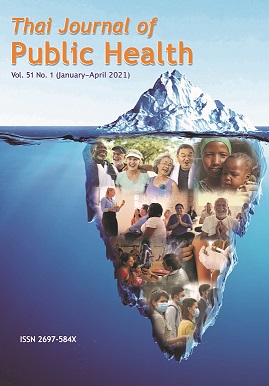Patterns of Kratom Use among Male Drug Users in the Deep South of Thailand
Keywords:
Kratom, Polydrug use, Southern ThailandAbstract
Kratom (Mitragyna speciosa) is a psychoactive plant which is native to Southeast Asia and is currently used recreationally. Psychoactive substances in kratom can interact with other substances and result in fatal physiological effects. However, no study has assessed substance use among men who used kratom in the deep south of Thailand. The objective of this study was to describe the patterns of kratom use among drug users in the deep south of Thailand and their associated factors. We established data collection sites in three provinces in the deep south region of Thailand and recruited 414 male drug users to participate in a survey interview by respondent-driven sampling. We assessed participant characteristics, self-reported history and patterns of drug use, and history of treatment for drug addiction using descriptive statistics and multivariate logistic regression analyses. Overall, 353 (85.3%) reported using kratom in the past 6 months. Among men who used kratom, 218 (61.8%) reported polydrug use, most commonly with methamphetamine. Kratom polydrug use was less common among those from Yala Province and among those who used drugs with peers. Kratom polydrug use was more common among those who had received drug treatment within the past 6 months, those who had received treatment ≥2 times, and those who had received treatment from facilities that were potentially connected to the Thai military. Treatment providers from the non-health sectors should make sure to comprehensively assess and ensure availability of treatments for multiple drug use.
References
Adkins JE, Boyer EW, McCurdy CR. Mitragyna speciosa, a psychoactive tree from Southeast Asia with opioid activity. Curr Top Med Chem 2011; 11(9): 1165–75.
Saingam D, Assanangkornchai S, Geater AF, Lerkiatbundit S. Factor analytical investigation of Krathom (Mitragyna speciosa Korth.) withdrawal syndrome in Thailand. J Psychoactive Drugs 2016; 48(2): 76–85.
Narcotics Control Division. Narcrotics Act B.E.2522 (1979). Available from: http://www.fda.moph.go.th/sites/Narcotics/en/Shared%20Documents/Narcotics-Act-B.E.2522.pdf, accessed 23 Oct, 2020.
Angkurawaranon C, Jiraporncharoen W, Likhitsathian S, Thaikla K, Kanato M, Perngparn U, et al. Trends in the use of illicit substances in Thailand: results from national household surveys. Drug Alcohol Rev 2018; 37(5): 658–63.
Likhitsathian S, Jiraporncharoen W, Aramrattana A, Angkurawaranon C, Srisurapanont M, Thaikla K, et al. Polydrug use among kratom users: findings from the 2011 Thailand National Household Survey. J Subst Use 2018; 23(4): 384–9.
Wichaidit W. Trauma from armed conflict and the effect on mental health in Thailand’s deep south: a systematic review. J Clin Diagn Res 2018; 12: VE01–6.
Assanangkornchai S, Muekthong A, Sam-angsri N, Pattanasattayawong U. The use of Mitragynine speciosa (“Krathom”), an addictive plant, in Thailand. Subst Use Misuse 2007; 42(14): 2145–57.
Ngamkham W. Thailand: Kratom juice cocktail the rage with young Muslims. Bangkok Post 2007. Available from: http://www.mapinc.org/drugnews/v07.n1431.a08.htm, accessed 23 Oct, 2020.
Saingam D, Assanangkornchai S, Geater AF, Balthip Q. Pattern and consequences of krathom (Mitragyna speciosa Korth.) use among male villagers in southern Thailand: a qualitative study. Int J Drug Policy 2013; 24(4): 351–8.
Holler JM, Vorce SP, McDonough-Bender PC, Magluilo JJ, Solomon CJ, Levine B. A drug toxicity death involving propylhexedrine and mitragynine. J Anal Toxicol 2011; 35(1): 54–9.
Neerman MF, Frost RE, Deking J. A drug fatality involving Kratom. J Forensic Sci 2013; 58 Suppl 1: S278-79.
Tungtananuwat W, Lawanprasert S. Fatal 4x100: Home-made Kratom juice cocktail. J Health Res 2011; 24(1): 43–7.
WHO. Lexicon of alcohol and drug terms. World Health Organization 1994 Available from: http://www.who.int/substance_abuse/terminology/who_ladt/en/, accessed 23 Oct, 2020.
SGI Global. Afghanistan National Drug Use Survey 2015. p 8–14. Available from: https://www.issup.net/knowledge-share/publications/2016-10/afghanistan-national-drug-use-survey-2015, accessed 23 Oct, 2020.
UNODC. Drug use in Pakistan 2013. Available from: https://www.unodc.org/documents/pakistan/Survey_Report_Final_2013.pdf, accessed 23 Oct, 2020.
Chongsuvivatwong V. Analysis of epidemiological data using R and Epicalc. Songkhla: Epidemiology Unit, Prince of Songkla University; 2015. 314 p.
Barr AM, Panenka WJ, MacEwan GW, Thornton AE, Lang DJ, Honer WG, et al. The need for speed: an update on methamphetamine addiction. J Psychiatry Neurosci JPN 2006; 31(5): 301–13.
Chan GCK, Kelly AB, Hides L, Quinn C, Williams JW. Does gender moderate the relationship between polydrug use and sexual risk-taking among Australian secondary school students under 16 years of age? Drug Alcohol Rev 2016; 35(6): 750–4.
Kokkevi A, Kanavou E, Richardson C, Fotiou A, Papadopoulou S, Monshouwer K, et al. Polydrug use by European adolescents in the context of other problem behaviours. Nord Stud Alcohol Drugs 2014; 31(4): 323–42.
LLP Channel News. Drug treatment clients in military bases are known as the ‘Citizen Reformation Students’ Available from: https://www.llpch.news/2019/05/08/18381/, accessed 23 Oct, 2020.
Department of Probation. Data on drug rehabilitation facilities according to the Drug Users Rehabilitation Act of 2002. Available from: http://probation.go.th/contentmenu.php?id=320, accessed 23 Oct, 2020.
Latkin CA, Edwards C, Davey-Rothwell MA, Tobin KE. The relationship between social desirability bias and self-reports of health, substance use, and social network factors among urban substance users in Baltimore, Maryland. Addict Behav 2017; 73: 133–6.
Latkin CA, Mai NVT, Ha TV, Sripaipan T, Zelaya C, Le Minh N, et al. Social desirability response bias and other factors that may influence self-reports of substance use and HIV risk behaviors: a qualitative study of drug users in Vietnam. AIDS Educ Prev Off Publ Int Soc AIDS Educ 2016; 28(5): 417–25.
Etikan I, Alkassim R, Abubakar S. Comparison of snowball sampling and sequential sampling technique. Biom Biostat Int J 2016; 1(3): 6–7.
Downloads
Published
Issue
Section
License
Creative Commons License CC-BY-ND


